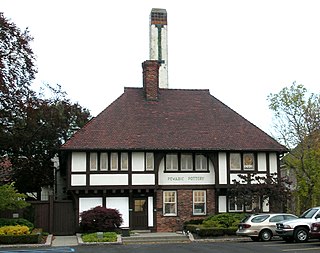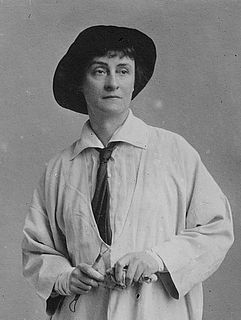Early life and family
The four Overbeck sisters who became involved in making pottery were: Margaret (July 3, 1863 – August 13, 1911); Hannah Borger (March 14, 1870 – August 28, 1931); Elizabeth Gray (October 21, 1875 – December 1, 1936); and Mary Frances (January 28, 1878 – March 20, 1955). [1] Their other siblings were Ida Alice (September 22, 1861 – 1946), Harriet Jane (January 17, 1872 – 1951), and an only brother, Charles (February 1, 1881 – 1913). [2] The siblings changed the spelled of their surname from "Overpeck" to Overbeck around 1911. [3]
Their parents, John Arehart Overpeck (1828–1904) and Sarah Ann (Borger) Overpeck (1840–1906), moved to Jackson Township, Wayne County, Indiana, from Overpeck, Butler County, Ohio, in 1868. The family relocated to a home on the east side of present-day Cambridge City, Indiana, in 1883. John Overpeck, a farmer and amateur cabinetmaker, was of German ancestry; Sarah Ann Overpeck, a homemaker who made quilts, rugs, and lace, was of Austrian and German ancestry. [3] [4] Their children grew up in Cambridge City and attended local public elementary and high school schools. At home the family was involved in creative arts, such as music, woodworking, textile arts, painting, and eventually ceramics. [5]
Sarah Ann Overpeck discouraged her daughters from marrying; she felt that marriage would "limit their ability to fulfill their creative potential." [6] Although Ida and Charles would later marry, Margaret, Elizabeth, Hannah, Mary Frances, and Harriett Overbeck chose not to marry. [7] After the death of their parents in the early 1900s, the siblings retained ownership of their parents' property in common. Ida and her husband, Martin Funk, and Charles and his wife, Hallie (Hill) Overbeck, relinquished their rights to the family's Cambridge City home to Hannah, Elizabeth, Harriet, and Mary Frances after Margaret's death in 1911. [3]

Margaret Overbeck
Margaret attended the Art Academy of Cincinnati in the 1890s. She also studied with the influential designer, Arthur Wesley Dow, of Columbia University, and with Marshall Fry, a New York china painter and potter. [8] [9] Margaret may have taught art to her younger sisters before she began work as an art instructor at private schools, including the Sayre Institute in Lexington, Kentucky, and Megguier Seminary in Boonville, Missouri. In 1899 Margaret took a faculty position at DePauw University in Greencastle, Indiana, where she taught art, but left the university in 1907 after suffering serious head injuries in an automobile accident in Chicago, Illinois. Margaret returned to the family home in Cambridge City to recuperate. [8] [10]
In addition to her work as an art teacher, Margaret exhibited a watercolor at the World's Fair in St. Louis, Missouri in 1904. [11] She was also a contributor to Keramic Studio, a china-painting publication. Her designs appeared in several issues of the specialty magazine between 1903 and 1913, most notably the March 1907 issue. [8] [12]
After working at a Zanesville, Ohio, pottery studio during the summer of 1910, [10] Margaret returned home to Cambridge City, where she established an art-pottery studio with her sisters, Elizabeth, Hannah, and Mary Frances. Margaret is generally credited with the idea of the sisters establishing Overbeck Pottery in the family's Cambridge City home. [9] She lived long enough to see the business established in early 1911, but died in Cambridge City on August 13, 1911, of complications attributed to her earlier injury in an automobile accident. [8] [13]
Hannah Overbeck
Hannah initially studied photography with her older sister, Ida, before attending Indiana State Normal School (present-day Indiana State University) in Terre Haute, Indiana. After her graduation from college in 1894, Hannah taught school for a year in Clinton, Indiana, but ill health forced her to return home. [8] [9]
Hanna was a skilled sketch artist, who also painted with watercolors. From 1904 to 1916 she contributed designs to Keramic Studio. At the Overbeck pottery studio Hannah and her sister, Mary Frances, were primarily responsible for the pottery's decorative designs. Her original design motifs were inspired from nature. She also made hand-formed pottery without the use of a potter's wheel. [13] [14] Chronic neuritis during the final years of her life made it difficult for Hannah to hold a pencil and draw, but she continued to work on designs until her death on August 28, 1931. [1] [15]
Elizabeth Overbeck
Elizabeth was an art student of her sister, Margaret. During 1909–10 Elizabeth studied ceramics under the direction of Charles Fergus Binns at the New York School for Clayworking (the present-day New York State College of Ceramics at Alfred University) in Alfred, New York. [10]
Elizabeth, the technician of the Overbeck pottery enterprise, was the only one of the sisters to use a potter's wheel to form her pottery. [9] In addition, she formulated and mixed the ceramic glazes, as well as supervising kiln operations. Elizabeth became especially known for her innovative pottery forms and her skills in developing new glazes and ceramic processes. [16] She died on December 1, 1936, leaving her younger sister, Mary Frances, to continue making pottery on her own. [1]
Mary Frances Overbeck
Mary Frances, along with her sister, Margaret, studied with Arthur Wesley Dow and Marshall Fry. [14] Mary Frances may also have studied at Indiana State Normal School. Trained as an artist in the mediums of oil, watercolor, and pen-and-ink illustration, Mary Frances's specialty was bird paintings. She also became well known for her bookplate designs. [17] Prior to establishing the pottery studio in Cambridge City with her sisters, Mary Frances taught in the public schools at Boulder, Colorado, and at Cambridge City and Centerville, Indiana. Between 1904 and 1916 Mary Frances contributed flower studies that were published in Keramic Studio. [14]
Mary Frances and her sister, Hannah, designed and decorated the Overbeck sisters' pottery. Their primary role was to paint, finish, and decorate the pottery before Elizabeth fired them in the kiln behind their home. Mary Frances's decorations were highly stylized, mostly geometric designs. She also created unique, one-of-a-kind, handmade pottery forms without using a potter's wheel. [9] [11] In addition, she created small figurines of people, animals, and birds. Mary Frances and her sisters also created fanciful, 4-inch (10 cm) to 5-inch (13 cm) figures they called "grotesques." Mary Frances referred to these small, figural caricatures of people and animals as "humor of the kiln." [17] [18] Mary Frances continued to operate Overbeck Pottery after the deaths of her sisters, but she primarily focused on making decorative figurines instead of large ceramic pieces. She died on March 20, 1955. [19]
Other Overbeck siblings
Harriet Jane Overbeck trained as a musician in Chicago, Illinois; Cincinnati, Ohio; and at Leipzig, Germany. She was also proficient in French, German, and Italian languages. Harriett gave private lessons in music and foreign languages at the family home in Cambridge City in addition to her role as housekeeper for her sisters. She died in 1947. [7] [20]
Ida Alice, the eldest sister, was the only sister to marry. She established a photography studio in Cambridge City around 1890, and married Martin Funk in 1893. Ida was not involved in the Overbeck pottery business. [3] [7] She died in 1946.
Charles Borger Overbeck, the youngest sibling, was a graduate of Purdue University and became an engineer. He died in 1913. Charles and his wife, Hallie, had two children, Virginia and Charles Jr. [3] [21]









